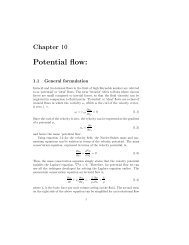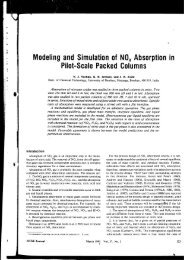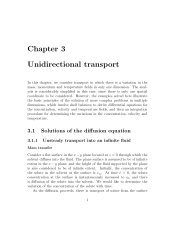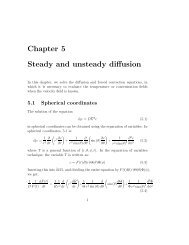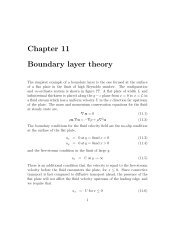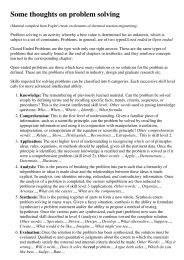You also want an ePaper? Increase the reach of your titles
YUMPU automatically turns print PDFs into web optimized ePapers that Google loves.
6 CHAPTER 9. VISCOUS FLOW<br />
The velocity field in the momentum equation can be separated into two<br />
parties, a ‘homogeneous solution’ which satisfies<br />
and a particular solution which satisfies<br />
∂ 2 i u (h)<br />
i = 0 (9.12)<br />
µ∂ 2 i u(p) i = ∂ i p (9.13)<br />
The particular solution is any one solution to the equation 9.13. One solution<br />
which satisfies equation 9.13 is<br />
u (p)<br />
i = 1<br />
2µ px i (9.14)<br />
This solution can be verified as follows. If we take the gradient of the particular<br />
solution 9.14, we get<br />
∂ j u (p)<br />
i = 1<br />
2µ (x i∂ j p + pδ ij ) (9.15)<br />
Upon taking the divergence of the above equation, we get<br />
∂j 2 u(p) i = 1<br />
2µ (2δ ij∂ j p + x i ∂j 2 p)<br />
= 1 µ ∂ ip (9.16)<br />
Therefore, the velocity fields can be obtained by solving the Laplace equation<br />
for the pressure and the homogeneous part of the velocity fields, and using<br />
equation 9.16 to obtain the particular part of the velocity field.<br />
We have already studied the solution for the Laplace equation,<br />
∇ 2 φ = 0 (9.17)<br />
which are obtained using separation of variables. In the present chapter, we<br />
derive the same solutions using the more convenient indicial notation. The<br />
fundamental solution for the Laplace equation in three dimensions, correct<br />
to within a multiplicative constant (which is determined from the boundary<br />
conditions, is<br />
Φ (0) = 1 r<br />
(9.18)





